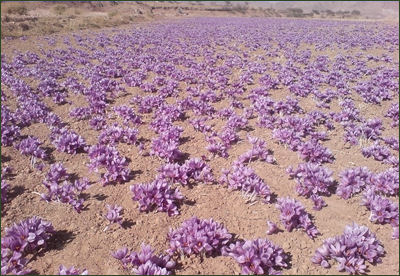SPICES

Istanbul spice market Commercial spice traders classify seasonings into three categories: 1) "True spices" — roots, bark, seeds, or fruit of aromatic plants usually grown in the tropics; 2) herbs — the leaves of aromatic plants often grown in temperate climates; and 3) aromatic seeds — fruits of seeds of herb plants.
1) "True spices" include allspice, black pepper, chili pepper, cinnamon, cloves, ginger, mace, nutmeg, paprika, red peppers, saffron, turmeric, white pepper. 2) Herbs include basil, bay leaves, chervil, marjoram, mint, oregano, parsley, rosemary, sage, savory, tarragon, thyme. 3) Aromatic seeds include anise, caraway, cardamom, celery, coriander, cumin, dill, fennel, fenugreek, mustard, poppy, sesame.
1) Tropical Asia is the traditional source of black pepper, white pepper, cinnamon, cloves, ginger, mace, nutmeg, dill, cardamom seed, celery seed, and red pepper. 2) Tropical Africa is the traditional source of red pepper and ginger. 3) The Caribbean is the traditional source of allspice, ginger, nutmeg and mace. 4) Mexico and Central America is the traditional source of red peppers, fennel, oregano, cardamon, coriander and sesame seeds. And 5) Europe is the traditional source of paprika, saffron, basil, bay leaves, marjoram, mint, rosemary, sage, tarragon, caraway seeds, poppy.
See Separate Article CLOVES, CINNAMON, MACE AND NUTMEG: THE SPICE ISLANDS SPICES factsanddetails.com
Websites and Resources: Different Spices spice-trade.com/types-of-spices ; Spice Plants uni-graz.at/~katzer ; Spice Farming spices.indianetzone.com/1/spice_farming.htm ; History of Spice Trade celtnet.org.uk/recipes/spice_trade ; History Spices, Spices Indian Trade Zone spices.indianetzone.com/ ; Encyclopedia of Spices theepicentre.com/Spices ; McCormik Spice Encyclopedia mccormick.com ; Wikipedia article on Spices Wikipedia ; Wikipedia article on the Spice Trade Wikipedia ; Book: “ Spice” by Jack Turner (Knopf, 2004)
Spices and the Silk Road
Spices such as cinnamon, cloves and nutmeg that were traded on the Silk Road originated from the East Indies. Pliny wrote of how cinnamon and other spices from Indonesia reached Rome via Madagascar and East Africa. By the A.D. 1st century, spices were making their way to China and India and from there taken by ship and Silk Road caravans to Europe.
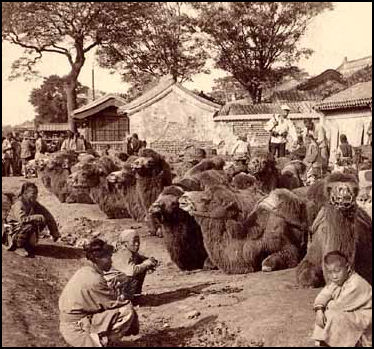
Spices were among the most valuable commodities carried on the Silk Road. Without refrigeration food spoiled easily and spices were important for masking the flavor of rancid or spoiled meat. Basil, mint, sage, rosemary and thyme cold be grown in family herb gardens in Europe along with medicinal plants. Among the the spices and seasonings that came from the East--affordable to merchants and burghers but not ordinary people--were pepper, cloves, mace and cumin. Ginger, nutmeg, cinnamon and saffron--the most valuable of spices from the East--were worth more than their weight in gold.
Pepper, one of the spices that Columbus was looking for when he landed in the America in 1492, had been coming to Europe along the Silk Road at least since Roman times, when many Roman cookbook recipes called for pepper. In the A.D. first century, the satirist Persius wrote:
The greedy merchants, led by lucre, run
To the parch'd Indies and the rising sun
From thence hot Pepper and rich Drugs they bear,
Bart'ring for Spices their Italian ware...
During the Middle Ages, one medieval town sold 288 kinds of spices, many of whom had an unknown origin. Cinnamon, people were told, came from an exotic bird and cloves were netted in the Nile by Egyptians. Caravans that carried pepper were heavily armed.
See Separate Article SILK ROAD: PRODUCTS, TRADE, MONEY AND SOGDIAN MERCHANTS factsanddetails.com
Ancient Roman Spices and Sauces
Garlic was consumed by the ancient Egyptians and Greeks. The Romans regarded it as a food for the lower classes and legionnaires rubbed it on their bodies to ward off colds. The Romans gave garlic to laborers who did dangerous jobs to give them courage. Roman were especially fond of “ liquamen” , a sauce made from rotting fish guts, vinegar, oil, and pepper. Variants of the sauce were used on fish and fowl as far back as 300 B.C. It was said to be an aphrodisiac. Among the recipes discovered at Pompeii were mushrooms with honey-and-liquamen sauce, soft-boiled eggs with pine kernels and liquamen sauce, and venison with caraway seeds, honey and liquamen sauce.
Romans spiced their food with pine kernels, leeks, celery seeds, parsley, lovage, capons, dried mint, safflower, coriander, dates, honey, vinegar, raison wine and broth. Several towns were famous for the or condiment factories. Perhaps the most common flavoring additive was vinegar. Spoiled wine was used as vinegar (acetum), and vinegar that became insipid and tasteless was called vappa. This latter word was used also as a term of reproach for shiftless and worthless men. Wealthy Romans sometimes ate their food with elaborate sauces and spices. They called this “city eating." By the 1st century B.C., Romans were obtaining spices from India.
spices in MoroccoHarold Whetstone Johnston wrote in “The Private Life of the Romans”: “The Roman gardener gave great attention, too, to the raising of green stuffs that could be used for salads. Among these the sorts most often mentioned are cress and lettuce, with which we are familiar, and the mallow, no longer used for food. Plants in great variety were cultivated for seasoning. Poppy seed was eaten with honey as a dessert, or was sprinkled over bread before baking. Anise, cumin, fennel, mint, and mustard were raised everywhere. Besides these seasonings that were found in every kitchen garden, spices were brought in large quantities from the East, and rich men imported vegetables of large sizes or finer quality than could be raised at home. Honey took the place of sugar on the table and in cooking, for the Romans had only a botanical knowledge of the sugar cane. Vinegar was made from grapes. [Source: “The Private Life of the Romans” by Harold Whetstone Johnston, Revised by Mary Johnston, Scott, Foresman and Company (1903, 1932) forumromanum.org ]
The Romans were nuts about honey. It was added to all sorts of things. Cloves and sugar arrived in Europe during the Roman era. Sugar was used mainly as a sweetener for medicine. The stems of laserpithium, an herb from North Africa, were incredibly popular. Laserpithium was roasted as a vegetable and squeezed to get juices used as a flavoring. It was the chief export from Libya and one of the primary spoils of the Punic wars. Within two centuries it was consumed to extinction. Also See Pepper
Spice Cultivation and Processing
Spice cultivation is still largely done by hand. After being picked many spices are cleaned, washed and dried for five to 10 days. They are packed whole in bags or bales and shipped to a processor.
Spice processors take the spice shipments in the form of leaves, seeds, bark or buds and grind them in accordance with specifications unique to each spice. Special equipment is used to separate the ground spices from the fibrous materials.
Spice flavor is produced by volatile oils (called the essential oils) and oleoresins found in the whole spice. Sometimes they are taken out of their source materials. The essential oils can be removed by steam distillation. Certain solvents can be used to remove both the essential oils and oleoresins.
Ginger
Ginger is a highly aromatic spice with a pungent, flowery and lemony taste. Mentioned in the sacred writings of Confucius and in the Koran, it has been cultivated in China for over 3,000 years and has a long history of use as a medicine.
In India, it is regarded as an aphrodisiac and is mentioned in the “ Kama Sutra” . A 15th century tract prescribes an ointment made of honey and ginger for “Increasing the Dimensions of Small Members and Making Them Splendid.” In some places it is chewed to ward off evil spirits.
Ginger is one of the earliest spices known in Western Europe. It imported from India as far back as Greek times. In the Middle Ages and Renaissance it was used to ward off the plague and for a while was so popular it was placed in the table like pepper and salt. In 19th century Britain it was sprinkled in beer (the source of ginger ale) and placed on the back of horses to get them moving.
Ginger is cultivated from rhizome cuttings. It grows best in rich, well-drained loam in tropical climates with a pronounced, heavy rainy seasons and a hot dry season. The plants shoot in ten days and are harvested after nine to ten months.
Ginger comes from a creeping, perennial, evergreen plant indigenous to tropical India and China. Contrary to what most think ginger is not a root. It is a rhizome, an underground stem that grow sideways rather than down and has roots of its own.
Much of the world's ginger comes from India. The erect stem of the plant is between one and three feet tall. The leaves are bright green and six to eight inches long. Small yellow-green flowers grow in clusters from the leaves.
An essential ingredient in many Asian and Western dishes, ginger is often pounded with other spices into a paste which is often sauteed as the first part of preparing a dish. Gingerol is the chemical that gives ginger its pungency.
World’s Top Ginger Producing Countries
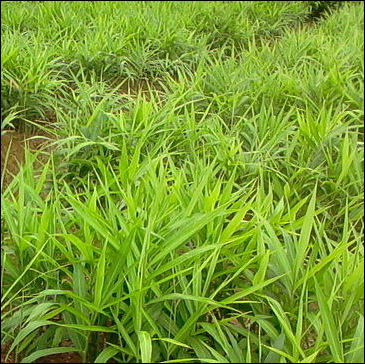
ginger farm World’s Top Producers of Ginger (2020): 1) India: 1844000 tonnes; 2) Nigeria: 734295 tonnes; 3) China: 618904 tonnes; 4) Nepal: 298945 tonnes; 5) Indonesia: 183518 tonnes; 6) Thailand: 167021 tonnes; 7) Bangladesh: 84887 tonnes; 8) Cameroon: 65453 tonnes; 9) Japan: 46136 tonnes; 10) Sri Lanka: 42019 tonnes; 11) Mali: 34861 tonnes; 12) Guyana: 34016 tonnes; 13) South Korea: 31538 tonnes; 14) Peru: 30086 tonnes; 15) Philippines: 27126 tonnes; 16) Taiwan: 22344 tonnes; 17) Malaysia: 11591 tonnes; 18) Fiji: 11409 tonnes; 19) Ethiopia: 10462 tonnes; 20) Bhutan: 8890 tonnes
[Source: FAOSTAT, Food and Agriculture Organization (U.N.), fao.org. A tonne (or metric ton) is a metric unit of mass equivalent to 1,000 kilograms (kgs) or 2,204.6 pounds (lbs). A ton is an imperial unit of mass equivalent to 1,016.047 kg or 2,240 lbs. ]
World’s Top Producers (in terms of value) of Ginger (2019): 1) India: Int.$1657935,000 ; 2) Nigeria: Int.$640956,000 ; 3) China: Int.$538863,000 ; 4) Nepal: Int.$275870,000 ; 5) Indonesia: Int.$161695,000 ; 6) Thailand: Int.$154780,000 ; 7) Cameroon: Int.$77365,000 ; 8) Bangladesh: Int.$74398,000 ; 9) Japan: Int.$42196,000 ; 10) Philippines: Int.$24970,000 ; 11) Peru: Int.$23956,000 ; 12) Taiwan: Int.$22241,000 ; 13) Mali: Int.$15890,000 ; 14) Sri Lanka: Int.$14546,000 ; 15) Ethiopia: Int.$10887,000 ; 16) Malaysia: Int.$10390,000 ; 17) Fiji: Int.$8714,000 ; 18) Côte d'Ivoire: Int.$6568,000 ; 19) Bhutan: Int.$5757,000 ; [An international dollar (Int.$) buys a comparable amount of goods in the cited country that a U.S. dollar would buy in the United States.]
Top Producing Countries: (Production, $1000; Production, metric tons in 2008, FAO): 1) India, 217856 , 382600; 2) China, 187227 , 328810; 3) Indonesia, 109520 , 192341; 4) Nepal, 100558 , 176602; 5) Thailand, 91962 , 161505; 6) Nigeria, 79717 , 140000; 7) Bangladesh, 43870 , 77046; 8) Japan, 28356 , 49800; 9) Philippines, 15680 , 27538; 10) Cameroon, 6263 , 11000; 11) Malaysia, 5887 , 10340; 12) Sri Lanka, 5722 , 10050; 13) Bhutan, 5620 , 9870; 14) Ethiopia, 5124 , 9000; 15) Côte d'Ivoire, 4669 , 8200; 16) Republic of Korea, 2027 , 3560; 17iji, 1393 , 2448; 18) Costa Rica, 543 , 955; 19) United States of America, 464 , 816; 20) Mauritius, 403 , 709;
World’s Top Ginger Exporting Countries

Ginger in a Chinese market
World’s Top Exporters of Ginger (2020): 1) China: 511094 tonnes; 2) India: 105117 tonnes; 3) Netherlands: 69473 tonnes; 4) Thailand: 60941 tonnes; 5) Peru: 50241 tonnes; 6) Nigeria: 35422 tonnes; 7) United Arab Emirates: 33838 tonnes; 8) Brazil: 31713 tonnes; 9) Myanmar: 20873 tonnes; 10) Nepal: 7326 tonnes; 11) Costa Rica: 5812 tonnes; 12) Spain: 4842 tonnes; 13) Germany: 4608 tonnes; 14) Tanzania: 3714 tonnes; 15) United States: 3695 tonnes; 16) Ecuador: 3678 tonnes; 17) Vietnam: 3611 tonnes; 18) Italy: 2664 tonnes; 19) Indonesia: 2370 tonnes; 20) Taiwan: 2029 tonnes. [Source: FAOSTAT, Food and Agriculture Organization (U.N.), fao.org]
World’s Top Exporters (in value terms) of Ginger (2020): 1) China: US$718454,000; 2) Netherlands: US$176914,000; 3) Peru: US$105643,000; 4) India: US$95262,000; 5) Thailand: US$61057,000; 6) Nigeria: US$51236,000; 7) Brazil: US$50250,000; 8) United Arab Emirates: US$45850,000; 9) Germany: US$20571,000; 10) Spain: US$14852,000; 11) Vietnam: US$12532,000; 12) Italy: US$8486,000; 13) United States: US$8319,000; 14) Myanmar: US$8230,000; 15) Costa Rica: US$7233,000; 16) Taiwan: US$6444,000; 17) United Kingdom: US$5214,000; 18) Indonesia: US$4440,000; 19) France: US$4395,000; 20) Ecuador: US$3822,000
World’s Top Ginger Importing Countries
World’s Top Importers of Ginger (2020): 1) Bangladesh: 132437 tonnes; 2) United States: 106321 tonnes; 3) Netherlands: 95285 tonnes; 4) Pakistan: 81761 tonnes; 5) Japan: 57164 tonnes; 6) United Arab Emirates: 55954 tonnes; 7) Malaysia: 50612 tonnes; 8) Saudi Arabia: 38201 tonnes; 9) United Kingdom: 28804 tonnes; 10) Germany: 27984 tonnes; 11) Canada: 20157 tonnes; 12) Indonesia: 19253 tonnes; 13) India: 15983 tonnes; 14) Russia: 14685 tonnes; 15) Yemen: 13352 tonnes; 16) Philippines: 12151 tonnes; 17) Thailand: 11204 tonnes; 18) Singapore: 11076 tonnes; 19) Spain: 10536 tonnes; 20) Kuwait: 9249 tonnes. [Source: FAOSTAT, Food and Agriculture Organization (U.N.), fao.org]
World’s Top Importers (in value terms) of Ginger (2020): 1) Netherlands: US$183564,000; 2) United States: US$173378,000; 3) Japan: US$106740,000; 4) Bangladesh: US$94930,000; 5) Pakistan: US$93782,000; 6) Germany: US$83375,000; 7) United Kingdom: US$64207,000; 8) Malaysia: US$60981,000; 9) Saudi Arabia: US$45497,000; 10) Canada: US$41507,000; 11) United Arab Emirates: US$41141,000; 12) Russia: US$37786,000; 13) France: US$25296,000; 14) Spain: US$24310,000; 15) Poland: US$22401,000; 16) Singapore: US$18476,000; 17) India: US$18419,000; 18) Italy: US$17073,000; 19) Indonesia: US$16933,000; 20) Morocco: US$15683,000 [Source: FAOSTAT, Food and Agriculture Organization (U.N.), fao.org]
Cardamom
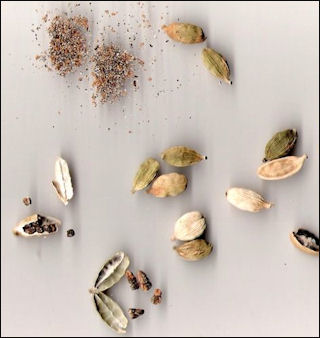
Cardamom dried seeds Cardamom is one of the most ancient spices and one of the most expensive (only saffron costs more). A member of the ginger family native to the Western Ghats region of southern India, it has a warm sweet and aromatic aroma, with camphorous, lemony and eucalyptus undertones, and is particularly popular in the Middle East, where it used as a flavoring for coffee. It is also used in a variety of foods and drinks in India and northern Europe.
The ancient Egyptians chewed cardamom as a teeth cleaner. The Greeks and Romans used as perfume. Vikings that traveled through Russia to Constantinople brought it back to Scandinavia, where it remains popular today. Arabs ascribed aphrodisiac qualities to it and was mentioned a number of times in “Arabian Nights” .
Cardamon comes from small, brown-black sticky seeds found in the pods of the cardamon plant. The pods are 5 to 20 millimeters long. The dried pods are rough wrinkled and have a texture like sandpaper. The pods are sold whole. The seeds are sold whole or ground. It is best to buy the pods or seeds whole. Ground cardamon quickly loses its flavor.
The cardamom bush reaches a height of 16 feet and has green flowers with a white, purple-veined tip and long tuberous, green leaves that are up to two feet long and six inches wide. The pods are found on leaf stalks that grow near the ground at the base of the plant.
Cardamon has traditionally been grown in partially cleared tropical rainforests, leaving some trees for shade. Today it is grown mostly on partially shaded plantations. The pods are collected before they open so the capsules don’t split open during drying. They are dried under the sun or with smoke from burnt coconut husks, roots and branches, and sometimes bleached with sulphur fumes.
World’s Top Nutmeg, Mace and Cardamom Producing Countries
Cardamon is grown in India, Sri Lanka, Guatemala, Southeast Asia and Tanzania. The wild version of the plant can still be found in southern India.

cardamomum Maton
(cardamom plant) World’s Top Producers of Nutmeg, Mace and Cardamoms (2020): 1) Indonesia: 42338 tonnes; 2) India: 41000 tonnes; 3) Guatemala: 38610 tonnes; 4) Nepal: 9545 tonnes; 5) Sri Lanka: 4120 tonnes; 6) Laos: 3053 tonnes; 7) Bhutan: 2175 tonnes; 8) Tanzania: 721 tonnes; 9) Grenada: 656 tonnes; 10) Honduras: 574 tonnes; 11) Trinidad and Tobago: 329 tonnes; 12) Saint Vincent and the Grenadines: 156 tonnes; 13) Ethiopia: 154 tonnes; 14) Papua New Guinea: 110 tonnes; 15) Malawi: 93 tonnes; 16) Kenya: 58 tonnes; 17) Malaysia: 43 tonnes; 18) Saint Lucia: 34 tonnes; 19) Togo: 33 tonnes; 20) Madagascar: 16 tonnes. [Source: FAOSTAT, Food and Agriculture Organization (U.N.), fao.org. A tonne (or metric ton) is a metric unit of mass equivalent to 1,000 kilograms (kgs) or 2,204.6 pounds (lbs). A ton is an imperial unit of mass equivalent to 1,016.047 kg or 2,240 lbs.]
World’s Top Producers (in terms of value) of Nutmeg, Mace and Cardamoms (2019): 1) Indonesia: Int.$171912,000 ; 2) Guatemala: Int.$150084,000 ; 3) India: Int.$148571,000 ; 4) Nepal: Int.$31098,000 ; 5) Sri Lanka: Int.$15174,000 ; 6) Laos: Int.$11894,000 ; 7) Grenada: Int.$10447,000 ; 8) Bhutan: Int.$5524,000 ; 9) Tanzania: Int.$2866,000 ; 10) Honduras: Int.$2103,000 ; 11) Trinidad and Tobago: Int.$1435,000 ; 12) Saint Vincent and the Grenadines: Int.$860,000 ; 13) Ethiopia: Int.$657,000 ; 14) Papua New Guinea: Int.$391,000 ; 15) Malawi: Int.$242,000 ; 16) Kenya: Int.$238,000 ; 17) Saint Lucia: Int.$137,000 ; 18) Togo: Int.$133,000 ; 19) Malaysia: Int.$133,000 ; [An international dollar (Int.$) buys a comparable amount of goods in the cited country that a U.S. dollar would buy in the United States.]
Top Producing Countries in 2008 (Production, $1000; Production, metric tons , FAO): 1) Guatemala, 40180 , 28000; 2) India, 22171 , 15450; 3) Indonesia, 12341 , 8600; 4) Nepal, 11688 , 8145; 5) Bhutan, 8323 , 5800; 6) Grenada, 4018 , 2800; 7) Lao People's Democratic Republic, 3874 , 2700; 8) United Republic of Tanzania, 1004 , 700; 9) Malaysia, 861 , 600; 10) Sri Lanka, 574 , 400; 11) Honduras, 502 , 350; 12) Saint Vincent and the Grenadines, 229 , 160; 13) Trinidad and Tobago, 222 , 155; 14) Ethiopia, 143 , 100; 15) Kenya, 71 , 50; 15) Malawi, 71 , 50; 17) Saint Lucia, 43 , 30; 17) Togo, 43 , 30; 19) Madagascar, 14 , 10; 20) Dominica, 7 , 5;
World’s Top Nutmeg, Mace and Cardamom Exporting and Importing Countries See Separate Article CLOVES, CINNAMON, MACE AND NUTMEG: THE SPICE ISLANDS SPICES factsanddetails.com
Basil
Basil is a member of the mint family. It comes from a small lime-green plant with tiny fragrant leaves. The most common variety is Italian sweet basil. There are dozens of other varieties such as Thai basil, purple basil and bush basil.
Basil is an important component in Italian dishes, especially pesto, a sauce made with basil, pine nuts, olive oil and Parmesan or pecorini cheese. Liguria, the thin coastal region bordering France, is Italy’s largest basil producing area, but is said the best tasting and most aromatic basil is grown at Pra in the hills just north of Genoa.
Garlic

Garlic is a clove found in the bulb of a plant that probably originated in Central Asia and western Siberia. Belonging to the genus of plants that also includes onions, leeks, shallots, scallions and chives, it is a common ingredient in French, Italian, Spanish, Chinese, Mexican, Korean, Hungarian and Thai cuisine. The bulbs have little smell. The most pungent smells are released when the gloves are cut open. People who eat a lot of garlic are advised to chew on parsley or yeast tablets to remove the bad breath smell.
Among the 300 varieties of garlic grown worldwide are California Later, California Early, Lerg, French, Elephant and Oriental Garlic is grown all over the world. The United States imports garlic from China, Mexico, Argentina, Chile, Taiwan and Spain.
Garlic was consumed by the ancient Egyptians. The pyramid builders ate lot of it along with onions. . One of the first recorded strikes occurred when their garlic ration was reduced. A slave could be bought for seven kilograms of it. The Greeks also ate garlic. The Romans regarded it as a food for the lower classes and legions wore it on their bodies to ward off colds.
In the Middle Ages, garlic was used as a remedy for bites from dogs and venomous creatures, plagues, sores, skin spots, acne, earaches, abscesses, worms, ulcers, and phlegm. By the 18th century it was widely eaten in Europe among people of all classes. The poet Shelly once wrote to a friend, "What do you think? Young women of rank eat — you will never guess what — garlic!"
Garlic is relatively easy to cultivate. It is harvested by hand after a tractor-pulled "knife" brings the bulbs up near the surface. The main problems with growing it are not enough water, too much rain, and soil depletion. After the harvest the plants are then dried for two weeks and the roots and stems are removed. Low-quality bulbs are sorted out and the remainder are pealed with a blast of air and "cracked" and divided into cloves in a special machine. Garlic pureed by machines is and used in things like barbecue sauces, salad dressing and a multitude of other products.
Garlic and Health
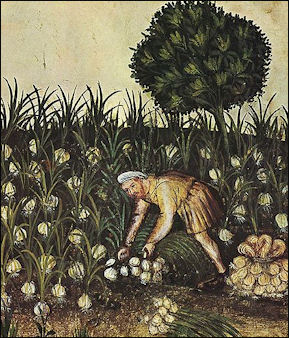
garlic harvesting Garlic contains many nutrients including vitamins A and C, phosphorous, potassium, selenium, amino acids, iron and calcium. Louis Pasteur demonstrated that garlics inhibits bacterial growth. It was used by British in World War I and the Russians in World War II as an antiseptic. Albert Schweitzer found it was useful treating cholera, typhoid and dysentery.
Today, doctors claim garlic fights bacteria, boosts the immune system, prevents blood clots, helps lower total cholesterol and blood pressure, raises HDL (good fat), limits the production of cancer-causing chemical, lowers triglyceride levels s and increases metabolism and may reduce the risk of cancer.
Garlic contains allicin, a chemical responsible for garlic's smell but which also has antibiotic and antifungal effects and is capable reducing high blood pressure. Garlic also has antibacterial and antiviral properties and is used as a treatment for hemorrhoids, heart disease, tuberculosis and even the common cold. Garlic also applications to agriculture. Garlic planted at the base of peach trees stops the destruction of peach borers;
A Chinese study shows that regular garlic consumption significantly lowers the risks of stomach cancer and my prevent colon cancer. The German government is so convinced of is health benefits it recommends it citizens to eat the equivalent of one clove a day.
World’s Top Garlic Producing Countries
World’s Top Producers of Garlic (2020): 1) China: 20712087 tonnes; 2) India: 2917000 tonnes; 3) Bangladesh: 485447 tonnes; 4) South Korea: 363432 tonnes; 5) Egypt: 333543 tonnes; 6) Spain: 269090 tonnes; 7) Uzbekistan: 223719 tonnes; 8) Ukraine: 211680 tonnes; 9) Myanmar: 211138 tonnes; 10) Russia: 189659 tonnes; 11) United States: 175674 tonnes; 12) Algeria: 170930 tonnes; 13) Brazil: 155700 tonnes; 14) Argentina: 146608 tonnes; 15) Ethiopia: 114945 tonnes; 16) Peru: 90612 tonnes; 17) Mexico: 86688 tonnes; 18) Pakistan: 85642 tonnes; 19) Indonesia: 81805 tonnes; 20) North Korea: 76867 tonnes [Source: FAOSTAT, Food and Agriculture Organization (U.N.), fao.org. A tonne (or metric ton) is a metric unit of mass equivalent to 1,000 kilograms (kgs) or 2,204.6 pounds (lbs). A ton is an imperial unit of mass equivalent to 1,016.047 kg or 2,240 lbs.]
World’s Top Producers (in terms of value) of Garlic (2019): 1) China: Int.$16801687,000 ; 2) India: Int.$2102159,000 ; 3) Bangladesh: Int.$336915,000 ; 4) South Korea: Int.$280050,000 ; 5) Egypt: Int.$230298,000 ; 6) Spain: Int.$196021,000 ; 7) United States: Int.$171452,000 ; 8) Algeria: Int.$161318,000 ; 9) Uzbekistan: Int.$156233,000 ; 10) Ukraine: Int.$155365,000 ; 11) Myanmar: Int.$150913,000 ; 12) Russia: Int.$146010,000 ; 13) Ethiopia: Int.$110233,000 ; 14) Argentina: Int.$106660,000 ; 15) Brazil: Int.$95011,000 ; 16) Indonesia: Int.$64161,000 ; 17) Thailand: Int.$60709,000 ; 18) Peru: Int.$60173,000 ; 19) Mexico: Int.$59893,000 ; [An international dollar (Int.$) buys a comparable amount of goods in the cited country that a U.S. dollar would buy in the United States.]
Top Garlic Producing Countries in 2008: (Production, $1000; Production, metric tons, FAO): 1) China, 9705664 , 12575036; 2) India, 497823 , 645000; 3) Republic of Korea, 289789 , 375463; 4) Egypt, 199598 , 258608; 5) Russian Federation, 174948 , 226670; 6) United States of America, 149910 , 194230; 7) Myanmar, 113457 , 147000; 8) Bangladesh, 111772 , 144817; 9) Spain, 109984 , 142500; 10) Argentina, 108054 , 140000; 11) Ukraine, 105584 , 136800; 12) Turkey, 81017 , 104970; 13) Ethiopia, 79915 , 103542; 14) Democratic People's Republic of Korea, 73322 , 95000; 15) Brazil, 66839 , 91714; 16) Thailand, 66104 , 85648; 17) Romania, 55828 , 72333; 18) Pakistan, 49241 , 63799; 19) Peru, 47130 , 67597; 20) Algeria, 43164 , 55925;
World’s Top Garlic Exporting Countries
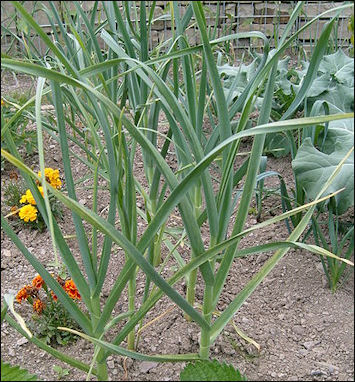
Allium sativum (garlic plant) World’s Top Exporters of Garlic (2020): 1) China: 2254192 tonnes; 2) Spain: 190427 tonnes; 3) Argentina: 97797 tonnes; 4) Egypt: 53207 tonnes; 5) United Arab Emirates: 46822 tonnes; 6) Netherlands: 34186 tonnes; 7) Mexico: 15880 tonnes; 8) Chile: 14236 tonnes; 9) Peru: 11894 tonnes; 10) Italy: 9903 tonnes; 11) France: 9388 tonnes; 12) Malaysia: 8389 tonnes; 13) Iran: 6786 tonnes; 14) Singapore: 5730 tonnes; 15) India: 4680 tonnes; 16) Slovenia: 3409 tonnes; 17) United States: 3367 tonnes; 18) South Korea: 3058 tonnes; 19) Vietnam: 2847 tonnes; 20) United Kingdom: 2805 tonnes. [Source: FAOSTAT, Food and Agriculture Organization (U.N.), fao.org]
World’s Top Exporters (in value terms) of Garlic (2020): 1) China: US$2063511,000; 2) Spain: US$479325,000; 3) Argentina: US$172931,000; 4) Netherlands: US$98525,000; 5) Italy: US$39750,000; 6) France: US$38313,000; 7) United Arab Emirates: US$38228,000; 8) Egypt: US$38110,000; 9) Chile: US$33404,000; 10) Mexico: US$26690,000; 11) Peru: US$26329,000; 12) United States: US$17806,000; 13) South Korea: US$9941,000; 14) Myanmar: US$7339,000; 15) Slovenia: US$7283,000; 16) Singapore: US$6642,000; 17) Malaysia: US$6441,000; 18) Poland: US$5947,000; 19) United Kingdom: US$5198,000; 20) India: US$5070,000
World’s Top Garlic Importing Countries
World’s Top Importers of Garlic (2020): 1) Indonesia: 587748 tonnes; 2) Brazil: 193511 tonnes; 3) Malaysia: 115178 tonnes; 4) Bangladesh: 102717 tonnes; 5) United States: 101559 tonnes; 6) Pakistan: 101010 tonnes; 7) Thailand: 78908 tonnes; 8) United Arab Emirates: 71689 tonnes; 9) Philippines: 67562 tonnes; 10) Russia: 62496 tonnes; 11) Saudi Arabia: 59661 tonnes; 12) United Kingdom: 42926 tonnes; 13) Netherlands: 41287 tonnes; 14) Sri Lanka: 35766 tonnes; 15) France: 31498 tonnes; 16) Germany: 30703 tonnes; 17) Italy: 29849 tonnes; 18) Colombia: 29846 tonnes; 19) Canada: 24240 tonnes; 20) Yemen: 23718 tonnes. [Source: FAOSTAT, Food and Agriculture Organization (U.N.), fao.org]
World’s Top Importers (in value terms) of Garlic (2020): 1) Indonesia: US$585785,000; 2) Brazil: US$289858,000; 3) United States: US$235003,000; 4) Malaysia: US$116455,000; 5) Germany: US$104832,000; 6) Pakistan: US$102361,000; 7) Russia: US$89981,000; 8) France: US$85811,000; 9) United Kingdom: US$81694,000; 10) Italy: US$79826,000; 11) Netherlands: US$79383,000; 12) Bangladesh: US$73954,000; 13) Saudi Arabia: US$60381,000; 14) United Arab Emirates: US$57799,000; 15) Canada: US$54728,000; 16) Mexico: US$50882,000; 17) Japan: US$48881,000; 18) Vietnam: US$48456,000; 19) Thailand: US$41958,000; 20) Sri Lanka: US$37080,000
Anise (Licorice)
Licorice is one of the world’s oldest known medicines. The root of the licorice plant were described in antiquity. Pliny the Elder discussed its ability to treat colds and asthma and heal wounds. Folk doctors and herbalists in China and India have used for centuries.
Glycyrrhizic acid is the main medicinal and sweetening compound in licorice. It is 50 times sweeter than sugar and kills cells infected by the virus that causes Kaposi’s Sarcoma, a cancer. It also inhibits the SARS virus and has been tested as a treatment for Japanese encephalitis, chronic hepatitis and HIV.
Red licorice contains no licorice.
World’s Top Anise and Corriander Producing Countries
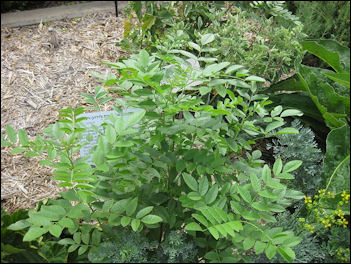
licorice plant
World’s Top Producers of Anise, Badian, Fennel, Coriander (2020): 1) India: 1431000 tonnes; 2) Turkey: 314999 tonnes; 3) Mexico: 132675 tonnes; 4) Syria: 70988 tonnes; 5) Iran: 60771 tonnes; 6) China: 50565 tonnes; 7) Russia: 36926 tonnes; 8) Egypt: 28923 tonnes; 9) Morocco: 27687 tonnes; 10) Afghanistan: 18387 tonnes; 11) Canada: 12128 tonnes; 12) Tunisia: 11318 tonnes; 13) Argentina: 6912 tonnes; 14) Ethiopia: 4884 tonnes; 15) Vietnam: 4389 tonnes; 16) Ukraine: 2870 tonnes; 17) Guatemala: 2112 tonnes; 18) North Macedonia: 1634 tonnes; 19) Tanzania: 1323 tonnes; 20) Australia: 1150 tonnes. [Source: FAOSTAT, Food and Agriculture Organization (U.N.), fao.org]
World’s Top Producers (in terms of value) of Anise, Badian, Fennel, Coriander (2019): 1) India: Int.$3147331,000 ; 2) Mexico: Int.$218574,000 ; 3) Syria: Int.$179722,000 ; 4) Iran: Int.$147362,000 ; 5) China: Int.$129141,000 ; 6) Turkey: Int.$100210,000 ; 7) Russia: Int.$81678,000 ; 8) Egypt: Int.$64712,000 ; 9) Morocco: Int.$62027,000 ; 10) Afghanistan: Int.$41352,000 ; 11) Canada: Int.$29721,000 ; 12) Tunisia: Int.$24142,000 ; 13) Ethiopia: Int.$13309,000 ; 14) Argentina: Int.$12696,000 ; 15) Vietnam: Int.$9881,000 ; 16) Guatemala: Int.$5056,000 ; 17) North Macedonia: Int.$3397,000 ; 18) Ukraine: Int.$3173,000 ; 19) Tanzania: Int.$3115,000 ; [An international dollar (Int.$) buys a comparable amount of goods in the cited country that a U.S. dollar would buy in the United States.]
World’s Top Anise and Corriander Exporting Countries
World’s Top Exporters of Anise, Badian, Fennel, Coriander (2020): 1) India: 357482 tonnes; 2) Syria: 39282 tonnes; 3) Russia: 31750 tonnes; 4) Iran: 26792 tonnes; 5) Egypt: 22923 tonnes; 6) United Arab Emirates: 19618 tonnes; 7) Bulgaria: 18689 tonnes; 8) Turkey: 17585 tonnes; 9) Italy: 16471 tonnes; 10) Afghanistan: 15176 tonnes; 11) Vietnam: 14748 tonnes; 12) China: 12260 tonnes; 13) Morocco: 10085 tonnes; 14) Spain: 8012 tonnes; 15) Ukraine: 7445 tonnes; 16) Germany: 5386 tonnes; 17) Netherlands: 5066 tonnes; 18) Canada: 4965 tonnes; 19) Poland: 4850 tonnes; 20) Lithuania: 4525 tonnes. [Source: FAOSTAT, Food and Agriculture Organization (U.N.), fao.org]
World’s Top Exporters (in value terms) of Anise, Badian, Fennel, Coriander (2020): 1) India: US$633182,000; 2) Syria: US$64028,000; 3) China: US$63476,000; 4) Turkey: US$47787,000; 5) Vietnam: US$46327,000; 6) Afghanistan: US$35122,000; 7) Egypt: US$31340,000; 8) Germany: US$29766,000; 9) United Arab Emirates: US$28543,000; 10) Italy: US$26608,000; 11) Russia: US$23122,000; 12) Spain: US$22040,000; 13) Netherlands: US$20426,000; 14) Bulgaria: US$18927,000; 15) Iran: US$14745,000; 16) Morocco: US$11708,000; 17) United Kingdom: US$10894,000; 18) France: US$8753,000; 19) Poland: US$8393,000; 20) United States: US$7814,000
World’s Top Mustard Producing Countries

Saffron in a Turkish market World’s Top Producers of Mustard Seed (2020): 1) Nepal: 214055 tonnes; 2) Russia: 103033 tonnes; 3) Canada: 98800 tonnes; 4) Myanmar: 38564 tonnes; 5) United States: 37090 tonnes; 6) China: 18426 tonnes; 7) Ukraine: 14040 tonnes; 8) Kazakhstan: 10735 tonnes; 9) Ethiopia: 2665 tonnes; 10) Serbia: 2432 tonnes; 11) Bhutan: 538 tonnes; 12) Sri Lanka: 63 tonnes; 13) Kyrgyzstan: 10 tonnes; 14) Iran: 3 tonnes
[Source: FAOSTAT, Food and Agriculture Organization (U.N.), fao.org. A tonne (or metric ton) is a metric unit of mass equivalent to 1,000 kilograms (kgs) or 2,204.6 pounds (lbs). A ton is an imperial unit of mass equivalent to 1,016.047 kg or 2,240 lbs.]
World’s Top Producers (in terms of value) of Mustard Seed (2019): 1) Nepal: Int.$148400,000 ; 2) Russia: Int.$116640,000 ; 3) Canada: Int.$95233,000 ; 4) Myanmar: Int.$28046,000 ; 5) Ukraine: Int.$27968,000 ; 6) United States: Int.$20405,000 ; 7) China: Int.$13035,000 ; 8) Kazakhstan: Int.$9077,000 ; 9) Ethiopia: Int.$1898,000 ; 10) Serbia: Int.$1700,000 ; 11) Bhutan: Int.$279,000 ; 12) Sri Lanka: Int.$107,000 ; 13) Kyrgyzstan: Int.$8,000 ; [An international dollar (Int.$) buys a comparable amount of goods in the cited country that a U.S. dollar would buy in the United States.]
Saffron
Saffron is the world's most expensive spice. It comes from the stigmas (the part of the flower that receives pollen) of purple crocus flowers and is used to color and give a flowery aroma to gourmet European dishes and meat and rice dishes in the Middle East and the Indian subcontinent. Over 200,000 stamens are needed to make one pound of saffron, which can sells for as much as $5,000. One acre of saffron yields only a few pounds. [Source: Diane Raines Ward, Smithsonian, August, 1988]
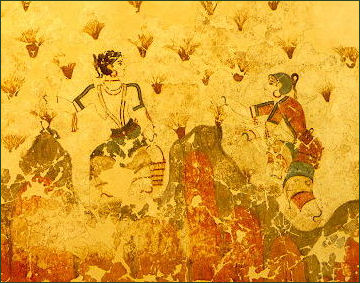
Saffron gatherers in
ancient Santorini fresco Saffron has been around a long time. Stigmas have been found in Egyptian mummies and Cleopatra used it in her cosmetics. In medieval Nuremberg a man was burned at the stake in a fire made from his attempts to make imitations of the spice. Saffron was introduced to Spain and Europe by Arab invaders around the 10th century. The Spanish word for saffron, “ azafrán” , comes from the Arabic word “ za'farãn” .
Most of world's saffron is purchased by Arabs (especially in Saudi Arabia and Kuwait) who use it flavor lamb, chicken and rice dishes. It is also an important ingredient in France's bouillabaisse and Italy's risotto. Over the centuries it also has been used as digestive, dye, hangover cure, stimulant and even an aphrodisiac.
Saffron Cultivation
Saffron is so expensive because nearly all the work is done by hand and the yields from all the work are very small. The flowers that produce the spice are small and fragile, and have to be picked by hand in such a way that the stigmas aren't crumpled. The planting, hoeing, stripping of the stigmas and roasting is also done by hand.
Saffron flowers are harvested almost as quickly as they bloom during a brief few days in October. "With balletic rhythm, men, women and children bend low and pluck the tiny blossoms and drop them in wicker baskets suspended from their waists," wrote Diane Raines Ward in Smithsonian magazine. "This backbreaking scene is repeated over and over, day after day, because that arrogant crocus wilts and its stigmas become worthless unless picked within hours of coming into full bloom."
After the saffron is harvested its precious red stigmas are stripped by hand and placed on large plates. Usually around to 70,000 to 100,000 stigmas equals one pound. The stigmas have to be removed carefully so they are not damaged and even the best strippers can only strip a few ounces a day. After a grower divided the stigmas into piles, the strippers choose the piles they want as wages. After being stripped, the stigmas are then slowly roasted on a mesh screen over a charcoal fire. Charcoal is preferred to butane because it doesn't spoil the aroma.
About 70 percent of the world's saffron crop used to come from Spain, where its known as "red gold." It is also grown in India, China, France, Spain and Iran.
Most of Spain's saffron comes from the same Castellan plains of La Mancha that Cervantes immortalized in Don Quixote. The area around the town of Consuegra is one of the prime saffron-growing regions in Spain. The crocus grow best in a moderate to dry climate with well drained sandy and loamy soil and adequate rainfall.
The crop is marketing through a long-standing network of village brokers, middlemen, big-city producers and exporters. The farmers make relatively little money, the brokers and exporters make the largest profits.
World’s Top Peppermint Producing Countries, Exporting and Importing Countries
saffron field World’s Top Producers of Peppermint (2020): 1) Morocco: 40403 tonnes; 2) Argentina: 6991 tonnes; 3) Mexico: 1010 tonnes; 4) Japan: 33 tonnes
[Source: FAOSTAT, Food and Agriculture Organization (U.N.), fao.org]
World’s Top Producers (in terms of value) of Peppermint (2019): 1) Morocco: Int.$190908,000 ; 2) Argentina: Int.$20076,000 ; 3) Mexico: Int.$1749,000 ; [An international dollar (Int.$) buys a comparable amount of goods in the cited country that a U.S. dollar would buy in the United States.]
World’s Top Exporters of Peppermint (2020): 1) Myanmar: 30175 tonnes; 2) Morocco: 757 tonnes; 3) Mali: 57 tonnes; 4) Syria: 54 tonnes; 5) Afghanistan: 44 tonnes
World’s Top Exporters (in value terms) of Peppermint (2020): 1) Myanmar: US$41019,000; 2) Morocco: US$1465,000; 3) Syria: US$135,000; 4) Afghanistan: US$28,000; 5) Mali: US$19,000
World’s Top Importers of Peppermint (2020): 1) Myanmar: 3611 tonnes; 2) Morocco: 251 tonnes; 3) Libya: 129 tonnes; 4) Bangladesh: 103 tonnes; 5) Tunisia: 89 tonnes; 6) Nigeria: 79 tonnes; 7) Chad: 36 tonnes; 8) Algeria: 7 tonnes; 9) Yemen: 6 tonnes
World’s Top Importers (in value terms) of Peppermint (2020): 1) Myanmar: US$2815,000; 2) Morocco: US$531,000; 3) Libya: US$127,000; 4) Nigeria: US$117,000; 5) Chad: US$83,000; 6) Tunisia: US$76,000; 7) Bangladesh: US$47,000; 8) Algeria: US$19,000; 9) Yemen: US$7,000
Salt
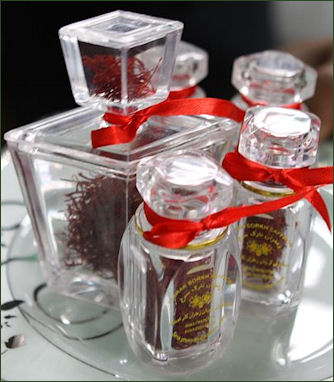
Afghan saffron
Salt is essential for life. Our bodies and the earth's surfaces are 70 percent salt water. Salt became a valuable commodity for mankind when meat started to be boiled. Human need salt and have traditionally gotten all the salt they needed from the animals they ate. Animal blood and roasted meat retain their salt, but boiling leaches the salt out. Later in history empires were founded and fortunes were made because salt is plentiful in some places but scarce in others. [Source: Gordon Young, National Geographic, September 1977]
Today only five percent of all salt consumed is used a seasoning. The rest is used in industry in manufacturing of textiles, rocket fuels, batteries, soaps, pharmaceuticals, pickles, and a host of other things. Salt, including its component elements sodium and chlorine, is the most widely used raw materials in industry, ahead of sulfur, limestone, coal and petroleum.
Salt is a terrific preservative. It draws moisture from meat and delays spoilage. Before refrigeration was invented, meat was salted to keep it from spoiling. As a preservative salt also made it possible for early ocean-going explorers like Columbus and Magellan to make long voyages.
Book: “Salt: A World History” by Mark Kurlansky (Walker, 2002).
Image Sources: Wikimedia Commons
Text Sources: National Geographic, New York Times, Washington Post, Los Angeles Times, Smithsonian magazine, Natural History magazine, Discover magazine, Times of London, The New Yorker, Time, Newsweek, Reuters, AP, AFP, Lonely Planet Guides, Compton’s Encyclopedia and various books and other publications.
Last updated March 2022


